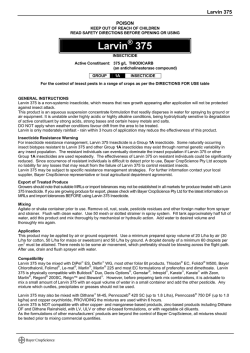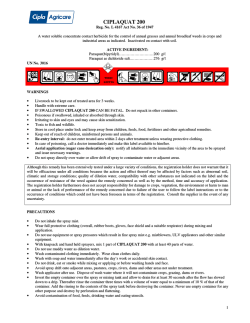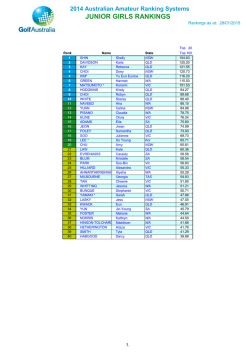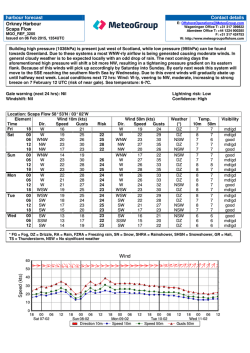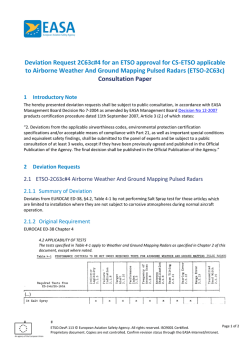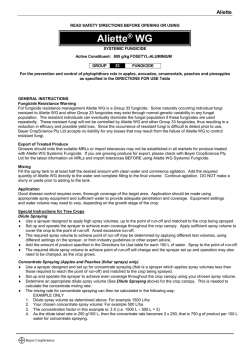
decis options® - Bayer CropScience
decis options POISON KEEP OUT OF REACH OF CHILDREN READ SAFETY DIRECTIONS BEFORE OPENING OR USING decis options® INSECTICIDE Active Constituent: GROUP 27.5 g/L DELTAMETHRIN 811 g/L LIQUID HYDROCARBONS 3A INSECTICIDE For the control of Heliothis (Helicoverpa spp.) and other specified pests on cotton and various other crops GENERAL INSTRUCTIONS Insecticide Resistance Warning For insecticide resistance management, Decis Options Insecticide is a Group 3A insecticide. Some naturally occurring insect biotypes resistant to Decis Options and other Group 3A insecticides may exist through normal genetic variability in any insect population. The resistant individuals can eventually dominate the insect population if Decis Options or other Group 3A insecticides are used repeatedly. The effectiveness of Decis Options on resistant individuals could be significantly reduced. Since occurrence of resistant individuals is difficult to detect prior to use, Bayer CropScience Pty Ltd accepts no liability for any losses that may result from the failure of Decis Options to control resistant insects. The user should seek advice, and monitor the performance, and if the results are not in accordance with expectations, contact the manufacturer immediately. Apparent resistance however, should not be confused with poor application, coverage or timing techniques. Decis Options may be subject to specific resistance management strategies. For further information contact your local supplier, Bayer CropScience representative or local agricultural department agronomist. Export of Treated Produce Growers should note that suitable MRLs or import tolerances may not be established in all markets for produce treated with Decis Options Insecticide. If you are growing produce for export, please check with Bayer CropScience Pty Ltd for the latest information on MRLs and import tolerances BEFORE using Decis Options Insecticide. Application and Equipment Decis Options is a contact spray. Thorough, even coverage is essential. Residual control of Decis Options may be reduced if heavy rainfall is received within 48 hours of application. Decis Options can be applied using water as a carrier, and from aircraft can also be applied ULV when in combination with a compatible ULV insecticide and/or oil as bulking agent. Ground Spray Standard low volume boom or high volume equipment may be used. Aircraft Applied with water - Decis Options may be applied by aircraft using water as a carrier. Water volumes of 20 to 30 L/ha have given satisfactory results. Applied ULV - Decis Options may also be used without dilution in mixture with some ULV products, as listed under Compatibility, or applied ULV in combination with D-C-Tron® Cotton Spray Oil, D-C-Trate® Anti-Evaporative Spray Oil or Ulvapron® Oil. A minimum spray volume, as described in the table below, should be applied ULV, using either a compatible ULV insecticide mixture partner and/or compatible oil as the bulking agent. DO NOT add water – use direct from the container. decis options CROP Canola (oilseed rape) Cereals Chickpeas, faba beans, lentils, linseed, safflower, vetch Cotton Field peas Lupins Maize Sweetcorn Sorghum Soybeans, navy beans, mung beans, and other seed and pod crops Sunflower PEST Corn earworm and native budworm (heliothis), looper Green vegetable bug Cutworms (Agrotis spp.) Native budworm, corn earworm (heliothis) Southern and common armyworm Green vegetable bug Webworm (Hednota pedionoma) Cutworms (Agrotis spp.) Corn earworm and native budworm (heliothis), looper Green vegetable bug Cutworms (Agrotis spp.) Native budworm (H. punctigera), cotton bollworm (H. armigera) Pink spotted bollworm Green mirid Corn earworm and native budworm (heliothis) Pea weevil (NSW only) Pea weevil (Vic, SA only) Cutworms (Agrotis spp.) Native budworm (H. punctigera) (NSW, Vic, SA, WA only) Native budworm (H. punctigera) (Qld, Tas, NT) Corn earworm (H. armigera) and looper Cutworms (Agrotis spp.) Green vegetable bug Corn earworm and native budworm (heliothis) MINIMUM TOTAL SPRAY VOLUME FOR ULV APPLICATION 2.5 L/ha 2.5 L/ha 1.0 L/ha 2.5 L/ha 2.0 L/ha 2.5 L/ha 1.0 L/ha 1.0 L/ha 2.5 L/ha 2.5 L/ha 1.0 L/ha 3.0 L/ha 2.5 L/ha 2.5 L/ha 1.25 L/ha 2.0 L/ha 1.5 L/ha 1.0 L/ha 1.0 L/ha 2.5 L/ha 2.5 L/ha 1.0 L/ha 2.5 L/ha 2.5 L/ha Corn earworm and native budworm (heliothis) Sorghum midge (Vic, SA, WA only) Sorghum midge (Qld, NSW, NT only) Corn earworm and native budworm (heliothis), looper Green vegetable bug 2.5 L/ha 2.5 L/ha 1.0 L/ha 2.5 L/ha 2.5 L/ha Corn earworm, native budworm (heliothis), Rutherglen bug, jassids 2.5 L/ha Please note: Berry vegetables (cape gooseberries, rosella), Cole crops (cabbage, cauliflower, Brussels sprouts, broccoli), Tobacco and Tomatoes should not be treated by ULV application. For ULV application, Decis Options must only be applied by aircraft fitted with accurately calibrated ULV equipment, e.g. Micronair AU5000 atomisers. To minimise drift it is essential to produce a suitable spray droplet diameter (volume mean diameter) by controlling the rotational speed of the atomisers. It is recommended that the application parameters in terms of plane speed and blade angle settings are adjusted to deliver a maximum rotational speed of 3000 rpm and a resultant droplet diameter of approximately 100 microns. Rotational speed of the atomisers can be measured by the fitment and maintenance of transducers. Thorough coverage is essential. Compatibility Applied with water - Decis Options may be mixed with most piperonyl butoxide formulations (e.g. Pipbut® Synergist) and most formulations of fungicides and insecticides such as chlorothalonil, dimethoate, mancozeb, metalaxyl, methamidophos, methomyl, methyl parathion, pirimicarb, Larvin® 375, Ovasyn® EC, Ovasyn Options, Predator* 300 and Curacron® Flexi, where these products are required for additional insect control or for control of diseases. Decis Options may also be mixed with other products including Reign™ Plant Growth Regulator, Wuxal® Liquid Foliar Nutrient and most knockdown herbicides. Decis Options and Larvin 800 WG are not compatible and should not be mixed. Applied ULV - When sprayed as a ULV product, Decis Options is compatible with Ovasyn Options, Ovasyn ULV, Pipbut Synergist, Predator 300 and Curacron Flexi, where these products are required for additional insect control. Decis Options is also compatible with D-C-Tron Cotton Spray Oil, D-C-Trate Anti-Evaporative Spray Oil and Ulvapron Oil. For further information on ULV insecticide compatibilities contact Bayer CropScience Pty Ltd. Warning: Decis Options may be mixed with some organophosphate insecticides for additional insect control. Organophosphate insecticides can cause phytotoxicity, which may be exaggerated with multiple applications. The addition of Decis Options to organophosphate insecticides does not affect the degree of phytotoxicity. decis options Mixing Applied with water - Fill the spray tank to about ¾ full with clean water. Add the required quantity of Decis Options to the spray tank with agitators in motion. Where other products are to be mixed, add these after Decis Options is mixed in the tank. Top up the spray tank to the required volume with clean water, with agitators operating. When mixing Decis Options with Pipbut Synergist, add the required quantity of Decis Options to the spray tank, followed by the Pipbut Synergist, then, with agitators operating, add the required quantity of clean water to the spray tank. Applied ULV - When Decis Options is to be applied as a ULV spray in combination with compatible ULV products (or oil), Decis Options should be added after the ULV product (or oil), with agitators in motion. Ensure that there is no water, or products containing water, in this mixture, or in the spraying equipment. PRECAUTIONS Re-entry Period Do not allow entry into treated areas until the spray deposits have dried. When prior entry is necessary, wear cotton overalls buttoned to the neck and wrist and elbow-length PVC gloves. Clothing must be laundered after each day’s use. DRIFT WARNING DO NOT apply under weather conditions, or from spraying equipment, which could be expected to cause spray to drift onto adjacent crops, crop lands, pastures or livestock. PROTECTION OF LIVESTOCK Dangerous to bees. DO NOT spray on any plants in flower while bees are foraging. Some repellent effect may be apparent for approximately 2 days. PROTECTION OF WILDLIFE, FISH, CRUSTACEANS AND ENVIRONMENT Dangerous to fish. DO NOT contaminate streams, rivers or waterways with this product or used container. STORAGE AND DISPOSAL Store in the closed, original container in a cool, secure, well-ventilated area. Do not store for prolonged periods in direct sunlight. 5, 20 and 200 L Triple or preferably pressure rinse containers before disposal. Add rinsings to spray tank. Do not dispose of undiluted chemicals on site. If recycling, replace cap and return clean containers to recycler or designated collection point. If not recycling, break, crush, or puncture and bury empty containers in a local authority landfill. If no landfill is available, bury the containers below 500 mm in a disposal pit specifically marked and set up for this purpose clear of waterways, desirable vegetation and tree roots. Empty containers and product should not be burnt. Container with dry-break connection (100 and 1000 L) If tamper evident seals are broken prior to initial use then the integrity of the contents cannot be assured. Empty container by pumping through dry-break connection system. Do not attempt to breach the valve system or the filling point, or contaminate the container with water or other products. Ensure that the coupler, pump, meter and hoses are disconnected, triple rinsed and drained after each use. When empty, or contents no longer required, return the container to the point of purchase. This container remains the property of Bayer CropScience Pty Ltd. Schütz container with camlock valve connection (1000 L) If tamper evident seals are broken prior to initial use, then the integrity of the contents cannot be assured. The container must be vented before discharging contents. To empty, connect a camlock fitted hose to the bottom valve. Remove top cap when discharging for venting purposes. When the container is empty, close all caps and valves and return the container to the point of purchase. SAFETY DIRECTIONS Product is poisonous if swallowed. Facial skin contact may cause temporary facial numbness. Will damage eyes and will irritate the skin. Avoid contact with eyes and skin. Avoid inhaling vapour or spray mist. When preparing spray, wear cotton overalls buttoned to the neck and wrist and a washable hat and elbow-length PVC gloves and face shield. If product in eyes, wash it out immediately with water. If product on skin, immediately wash area with soap and water. Wash hands after use. After each day’s use, wash gloves, face shield and contaminated clothing. FIRST AID If poisoning occurs, contact a doctor or Poisons Information Centre (telephone 13 11 26). If swallowed, do NOT induce vomiting. Give a glass of water. MATERIAL SAFETY DATA SHEET Additional information is listed in the Material Safety Data Sheet, which can be obtained from www.bayercropscience.com.au. EXCLUSION OF LIABILITY This product must be used strictly as directed, and in accordance with all instructions appearing on the label and in other reference material. So far as it is lawfully able to do so, Bayer CropScience Pty Ltd accepts no liability or responsibility for loss or damage arising from failure to follow such directions and instructions. decis options Decis Options®, Larvin®, Ovasyn®, Pipbut®, and Wuxal® are Registered Trademarks of Bayer. Reign™ - trademark applied for FOR 24 HOUR SPECIALIST ADVICE IN EMERGENCY ONLY PHONE 1800 033 111 APVMA Approval No.: 51849/1202 DIRECTIONS FOR USE CROP Berry vegetables; cape gooseberries, rosella Canola (oilseed rape) PEST Native budworm (heliothis, Helicoverpa spp.) STATE Qld, WA only RATE 50 mL/ 100 L WHP 1 day CRITICAL COMMENTS Apply as thorough spray. Use sufficient water to ensure adequate penetration and coverage. Repeat sprays at 7 to 14 day intervals, depending upon pest incidence. Corn earworm and native budworm (heliothis), looper Green vegetable bug All States 500 mL/ha 7 days Inspect crops regularly from early terminal development (4-leaf stage) onwards. Apply before heliothis or looper are 5 mm long. Apply as soon as adult green vegetable bugs are seen, before there is a build-up of nymphs. Cutworms (Agrotis spp.) Cereals Native budworm, corn earworm (heliothis) Southern and common armyworm Green vegetable bug Webworm (Hednota pedionoma) Cutworms (Agrotis spp.) Qld, NSW, Tas, SA, WA, NT only NSW, WA only All States 200 mL/ha 500 mL/ha 7 days Apply when larvae numbers exceed threshold. Qld, NSW, Tas, SA, WA, NT only WA only Apply as soon as adult green vegetable bugs are seen, before there is a build-up of nymphs. 200 mL/ha NSW only 200 mL/ha Pre-seeding: Decis Options may be tank mixed with knock down herbicides and applied prior to seeding. Apply once larvae have emerged, i.e. from last week in May onwards. Closely graze pasture prior to application. To ensure good penetration, use high water volume, i.e. 100 L/ha. Do not apply on dense pasture. Post crop emergence: inspect crop regularly from seeding onwards, and spray at first sign of damage. Check with local Department of Agriculture adviser for further details. Check emerging and establishing crops in the late afternoon or evening for caterpillars crawling on the soil surface and feeding on the seedlings. Spray in the late afternoon or evening. Apply at first sign of infestation, before larvae are 10 mm long, for best results. WA only Chickpeas, faba beans, lentils, linseed, safflower, vetch Corn earworm and native budworm (heliothis), looper All States Green vegetable bug Qld, NSW, Tas, SA, WA, NT only NSW, WA only Cutworms (Agrotis spp.) Check emerging and establishing crops in the late afternoon or evening for caterpillars crawling on the soil surface and feeding on the seedlings. Spray in the late afternoon or evening. Apply at first sign of infestation, before larvae are 5 mm, for best results. 500 mL/ha 7 days Inspect crops regularly from early terminal development (4-leaf stage) onwards. Apply before heliothis or looper are 5 mm long. Apply as soon as adult green vegetable bugs are seen, before there is a build-up of nymphs. 200 mL/ha Check emerging and establishing crops in the late afternoon or evening for caterpillars crawling on the soil surface and feeding on the seedlings. Spray in the late afternoon or evening. decis options CROP Cole crops: cabbage, cauliflower, Brussels sprouts, broccoli, etc. Cotton PEST Cabbage white butterfly, cabbage moth, cabbage centre grub Native budworm (H. punctigera), cotton bollworm (H. armigera) STATE Qld, NSW, NT only RATE High Volume: 50 mL/100 L or Low Volume: 500 mL/ha Vic, Tas, High SA, WA only Volume: 40 to 50 mL/100 L or Low Volume: 400 to 500 mL/ha Qld, NSW, 700 mL/ha WA, NT only WHP 2 days CRITICAL COMMENTS High Volume: Apply thorough spray to ensure even coverage, using at least 600 to 1000 L water/ha. Low Volume: Apply in sufficient water to obtain even and thorough coverage. Repeat sprays at 7 to 14 day intervals depending upon pest incidence. The addition of a wetting agent is recommended for both high and low volume spraying. Apply as above. Use the lower rate under low infestation levels. 7 days Use when insect reinfestation pressure is high (i.e. moderate to heavy egg laying is occurring and small to medium larvae are present). 600 mL/ha Use when low to moderate egg laying is occurring and only few small to very small larvae are present (see ‘note’ below). Use when egg laying is low and larvae are just about to hatch (see ‘note’ below). Apply at first sign of activity before larvae enter boll. Repeat as necessary. Suppression of green mirids. Apply when commercial thresholds are exceeded. 500 mL/ha Pink spotted bollworm Green mirid Field Peas 500 to 600 mL/ha 180 mL/ha Corn earworm and native budworm (heliothis) Qld, WA only Qld, NSW, WA, NT only NSW, Vic, SA, WA only Pea weevil NSW only 400 to 500 mL/ha 300 to 500 mL/ha Vic, SA only Cutworms (Agrotis spp.) NSW, WA only 250 to 500 mL/ha 200 mL/ha 7 days Inspect crops regularly and particularly at flowering and early podding. Apply as soon as infestation occurs. Use lower rates only when infestation is low and majority of larvae are young (ie. less than 5 mm). Large larvae are often not readily controlled. From start of flowering onwards check crops every 2 to 3 days with sweep net. If any pea weevil are present spray before first pods form. Check again 3 days after spraying and respray if necessary. Apply the higher rate under high infestation pressure Check emerging and establishing crops in the late afternoon or evening for caterpillars crawling on the soil surface and feeding on the seedlings. Spray in the late afternoon or evening. Thorough coverage is required for effective control. decis options CROP Lupins PEST Native budworm (H. punctigera) STATE NSW, Vic, SA only RATE 200 to 500 mL/ha WHP 7 days WA only Corn earworm (H. armigera), looper Cutworms (Agrotis spp.) Green vegetable bug Maize Sweetcorn Sorghum Corn earworm and native budworm (heliothis) Qld, Tas, NT All States 500 mL/ha Inspect crops regularly from early terminal development (4-leaf stage) onwards. Apply before heliothis or looper are 5 mm long. NSW, WA only 200 mL/ha Qld, NSW, Tas, SA, WA, NT only All States 500 mL/ha Check emerging and establishing crops in the late afternoon or evening for caterpillars crawling on the soil surface and feeding on the seedlings. Spray in the late afternoon or evening. Apply as soon as adult green vegetable bugs are seen, before there is a build-up of nymphs. Corn earworm and native budworm (heliothis) All States Sorghum midge Vic, SA, WA only Qld, NSW, NT only Soybeans, navy beans, mung beans and other seed and pod crops Corn earworm and native budworm (heliothis), looper Green vegetable bug Sunflower Corn earworm, native budworm (heliothis), Rutherglen bug, jassids CRITICAL COMMENTS Apply lower rate on small (5 mm) larvae and higher rate on dense canopies and/or larger larvae. Apply as above. Small caterpillars do not normally damage pods and numbers usually decline rapidly. Spraying is usually only necessary when caterpillars are about 20 mm in length. Apply thoroughly to ensure good penetration of lupin canopy. Low Volume: 500 mL/ha or High Volume: 50 mL/ 100 L 500 mL/ha 7 days 5 days Apply at tasselling and before silk emergence when larvae are small (less than 5 mm) and before they enter cob. Repeat sprays at 3 to 5 day intervals may be necessary, particularly for sweetcorn. For High Volume: apply as a thorough spray using 600 to 1000 L spray/ha, depending on plant size. 7 days Apply at first sign of pest, generally from head emergence onward. In tight head varieties, heliothis may be protected and not readily controlled. Repeat sprays as necessary. 200 to 400 mL/ha All States 500 mL/ha Qld, NSW, Tas, SA, WA, NT only All States 500 mL/ha 7 days 7 days Apply at first sign of infestation from head emergence and during flowering. Use rates towards the lower end of the range when infestation is light (1 to 2 midge/head) for knockdown effect late in the flowering period of sorghum. Use rates towards the higher end of the range when infestation occurs early in the period and/or under heavier infestation levels. Inspect crops regularly from early terminal development (4-leaf stage) onwards. Apply before heliothis or looper are 5 mm long. Apply as soon as adult green vegetable bugs are seen, before there is a build-up of nymphs. Apply at first sign of pest activity. Critical period is from bud stage/face opening onward. At later growth stages, pests may be partially protected by heads or bracts. Heliothis should be sprayed before they are 5 mm long for best results. Repeat sprays as necessary. If flowering has started and bees are active, application should be deferred until after flowering is complete but before the heads turn down. If treatment is unavoidable during flowering, spraying must take place in the very early morning or very late afternoon. decis options CROP Tobacco Tomatoes PEST Tobacco budworm, native budworm (heliothis), tobacco looper, tobacco stem borer Tomato grub and native budworm (heliothis) STATE Qld, NSW, WA only RATE 50 mL/100 L Vic only 40 to 50 mL/100 L High Volume: 50 mL/100 L or Low Volume: 500 mL/ha Qld, NSW, NT only Tas, WA only Vic, SA only Thrips Vic, SA, WA only High Volume: 40 to 50 mL/ 100 L or Low Volume: 400 to 500 mL/ha Programme Application: Low Volume: 300 to 500 mL/ha High Volume: 30 to 50 mL/100 L Established infestations: Low Volume: 500 mL/ha High Volume: 50 mL/100 L 300 mL/ha WHP 7 days 3 days CRITICAL COMMENTS Apply as thorough spray using 600 to 1000 L spray/ha depending on plant size. Repeat in 7 to 14 days or as required. Apply as above. Use lower rate under low infestation levels. Apply as thorough spray. Repeat sprays at 7 to 14 day intervals, depending upon pest incidence. High Volume: Use 600 to 1000 L spray/ha depending on plant size. Low Volume: Use sufficient water to ensure adequate penetration and coverage. Apply as above. Use lower rate under low infestation levels. Apply at first sign of pest activity. Repeat sprays at 7 to 14 day intervals depending on pest incidence. Use the higher rate when large larvae are present, and when reinfestation (egg-laying) is intense. Use also when insect re-infestation pressure is high. High Volume: Apply thorough spray to ensure even coverage, using at least 600 to 1000 L water/ha. Low Volume: Apply in sufficient water to obtain even and thorough coverage. Apply at first sign of infestation and repeat if necessary. Repeat applications may be necessary to control re-infestations, as residual control is limited. NOT TO BE USED FOR ANY PURPOSE, OR IN ANY MANNER, CONTRARY TO THIS LABEL UNLESS AUTHORISED UNDER APPROPRIATE LEGISLATION. WITHHOLDING PERIOD (WHP) Berry vegetables: DO NOT HARVEST FOR 1 DAY AFTER APPLICATION Cole crops: DO NOT HARVEST FOR 2 DAYS AFTER APPLICATION Tomatoes: DO NOT HARVEST FOR 3 DAYS AFTER APPLICATION Sweetcorn: DO NOT HARVEST FOR 5 DAYS AFTER APPLICATION Canola (oilseed rape), cereals, chickpeas, cotton, faba beans, field peas, lentils, linseed, lupins, maize, mung beans, navy beans, safflower, sorghum, soybeans, sunflower, tobacco, vetch and other seed and pod crops: DO NOT HARVEST FOR 7 DAYS AFTER APPLICATION Note: Larvae Size - Larvae greater than 5 mm are often not controlled satisfactorily as they are harder to kill and they are often protected from spray by the plant.
© Copyright 2025
